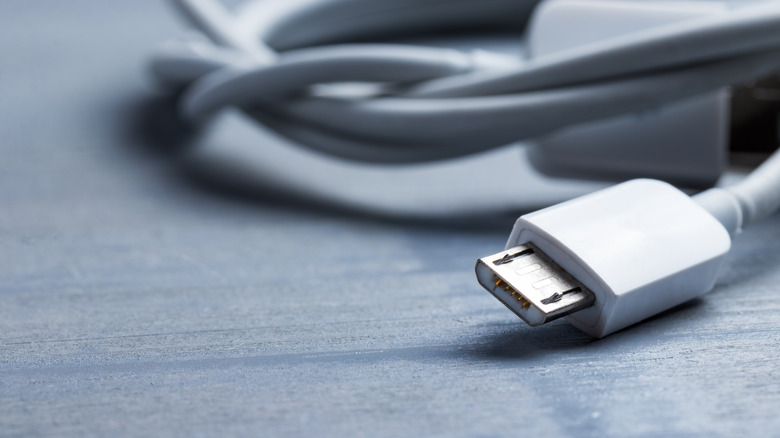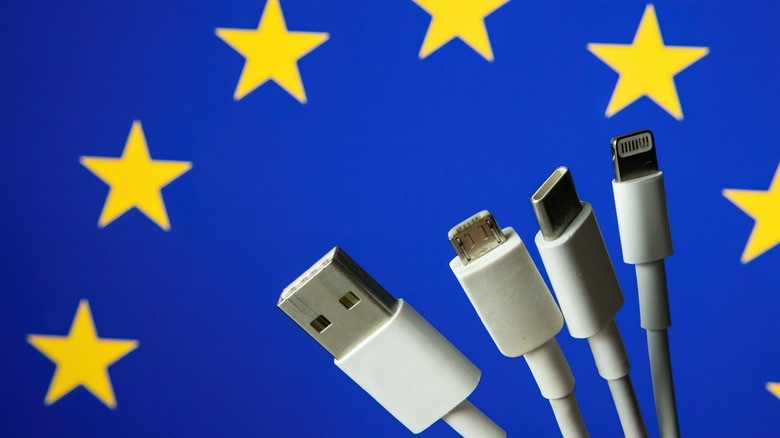Why Some New Gadgets Still Have Micro USB (And Why You Probably Shouldn't Buy Them)
The convenience of online shopping from major retailers means that it can be easy to impulse purchase gadgets without looking too closely at the details. When they arrive, you might find that they're not quite what you thought they were. Sometimes they might have a major flaw, but other times gadgets might just come with a few minor irritations. One frustratingly common issue is that it uses a different USB connector than what you were expecting, like using Micro USB instead of USB-C.
It's not necessarily a deal-breaking issue, but it's puzzling why new gadgets come with Micro USB at all when USB-C is superior in both speed and convenience. Jeff Ravencraft, president and COO of the USB Implementers Forum (USB-IF), was recently asked a similar question by The Verge and offered several reasons why Micro USB might still crop up in new gadgets. His first suggestion was that a new gadget might simply be less new in terms of design than you think it is. If a gadget has been in production for a number of years without major changes, it might simply be that you're buying a design from a time when USB-C was less commonly used.
A new gadget might still be old stock
Another potential reason that Ravencraft cited for Micro USB's continued appearance in gadgets is that, as well as being an older design, the gadget in question might also be old stock. There's often no easy way to verify exactly when a gadget was made, and if you're scrolling through Amazon, it can be easy to stumble across a listing for an older generation of a product without realizing it, since not all previous generation listings are clearly marked.
Even if the product in question isn't an older model, USB has evolved a lot between generations, and older connectors might be cheaper to buy than a USB-C connector. For penny-pinching gadget makers trying to squeeze maximum margins out of their product, that might be enough to justify sticking with the older technology.
It pays to be careful when shopping to ensure that you're buying the latest version of a gadget, and ideally verify that it comes with a USB-C connector rather than a more inconvenient Micro USB before you click "buy". If you do end up buying a gadget with Micro USB, think about whether you really want to keep it, or if it's worth returning it to the retailer.
Why shouldn't you buy Micro USB gadgets?
Whether or not a new Micro USB gadget is a worthwhile purchase ultimately comes down to personal preferences and your intended use for that gadget, but there are several good reasons to stay away. For starters, you'll likely have to use an adapter to connect the gadget to most modern devices. Even if you already have a suitable adapter to hand, it's simply another thing to keep track of and potentially misplace.
Micro USB is also likely to become even less common in the future. The European Union launched new regulations to ensure that all chargeable devices sold in the EU are compatible with USB-C. The legislation includes mobile phones, consoles, tablets, keyboards, and from 2026, will also cover laptops. Gadget makers won't want to design one version of a gadget for Europe and another for the rest of the world, so that legislation will have a global effect on gadget design. As a result, the Micro USB will almost inevitably be phased out. Since it doesn't offer any advantages over USB-C, it's probably best to avoid buying Micro USB gadgets in the meantime. It's much easier to be able to connect all of your gadgets with the same USB-C cable. Just make sure that, if you're buying a new USB-C cable, it's the right one, as not all of them are exactly the same.


